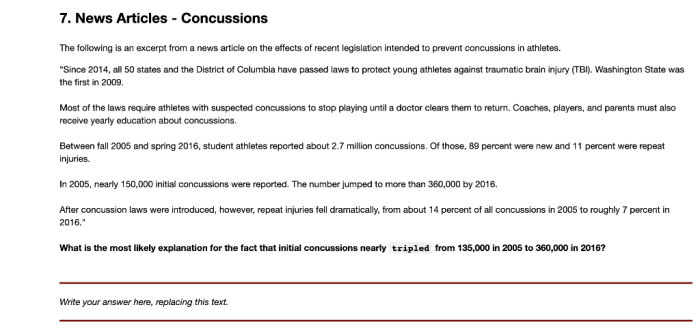Leaders role in concussion identification and management – The identification and management of concussions pose significant challenges, particularly in high-contact sports. Leaders play a pivotal role in ensuring the well-being of their team members by recognizing potential concussion symptoms, implementing proper protocols, and fostering a culture of concussion awareness and prevention.
This article delves into the multifaceted responsibilities of leaders in concussion management, highlighting their crucial role in ensuring player safety and minimizing the risks associated with this potentially serious injury.
Leaders’ Role in Concussion Identification and Management

Concussions are a common injury in sports, and leaders play a critical role in ensuring that they are identified and managed properly. This article will discuss the role of leaders in identifying concussions, managing concussions, educating and raising awareness about concussions, developing and implementing policies and procedures, and collaborating and supporting others in concussion management.
Leaders’ Role in Identifying Concussions
Leaders are often the first people to notice when a team member is exhibiting signs of a concussion. It is important for leaders to be aware of the common signs and symptoms of a concussion, which include:
- Loss of consciousness
- Confusion or disorientation
- Headache
- Nausea or vomiting
- Balance problems
- Sensitivity to light or noise
- Difficulty concentrating
- Memory problems
If a leader suspects that a team member has a concussion, it is important to remove the player from play immediately and seek medical attention. Concussions can be serious injuries, and it is important to get them diagnosed and treated as soon as possible.
Leaders’ Role in Managing Concussions
Once a team member has been diagnosed with a concussion, it is important for leaders to follow the proper concussion management protocols. These protocols typically involve a graduated return-to-play plan, which allows the player to gradually return to activity as their symptoms improve.
It is also important for leaders to communicate with the player’s medical team and parents about the player’s progress. This will help to ensure that the player is getting the best possible care and that they are not returning to play too soon.
Leaders’ Role in Educating and Raising Awareness
Leaders play a vital role in educating team members, parents, and the community about concussion risks and prevention. This can be done through a variety of methods, such as:
- Providing educational materials to team members and parents
- Hosting concussion awareness events
- Speaking to the media about concussions
By educating others about concussions, leaders can help to reduce the number of concussions that occur and ensure that those who do suffer a concussion get the best possible care.
Leaders’ Role in Policy Development and Implementation, Leaders role in concussion identification and management
Leaders can also play a role in developing and implementing concussion policies and procedures. These policies should be designed to prioritize player safety and minimize risks. They should also be clear and easy to understand, so that everyone involved in the sport knows what to do in the event of a concussion.
Leaders should also ensure that these policies are enforced and that everyone follows them. This will help to create a culture of concussion safety and ensure that all players are protected.
Leaders’ Role in Collaboration and Support
Collaboration is essential for effective concussion management. Leaders should work closely with medical professionals, parents, and other leaders to ensure that players are getting the best possible care. This includes sharing information, coordinating care, and providing support.
By collaborating with others, leaders can create a supportive environment for players who have suffered a concussion. This will help them to recover more quickly and return to play safely.
FAQ: Leaders Role In Concussion Identification And Management
What are some observable signs of a concussion?
Signs may include confusion, disorientation, memory loss, headaches, nausea, vomiting, balance problems, and sensitivity to light or noise.
Why is immediate removal from play crucial?
Continuing to play after a concussion can worsen symptoms and increase the risk of further injury, including more severe concussions or even life-threatening conditions.
What is the importance of a graduated return-to-play plan?
A graduated return-to-play plan allows individuals to gradually increase their activity levels while monitoring for any symptoms or setbacks, ensuring a safe and effective return to full participation.

